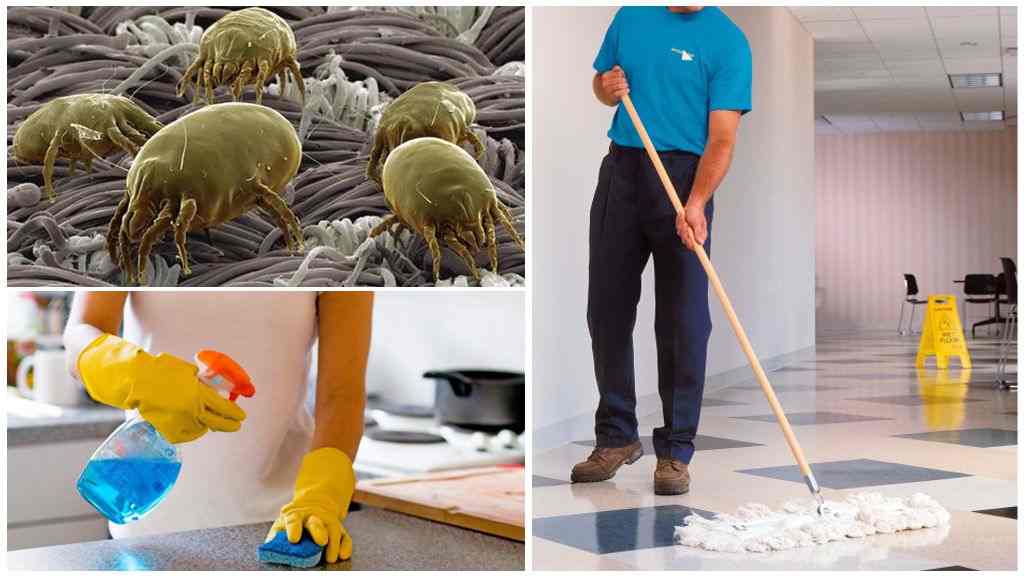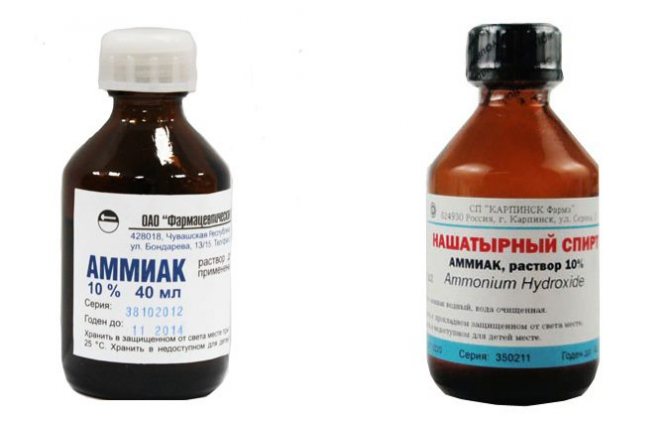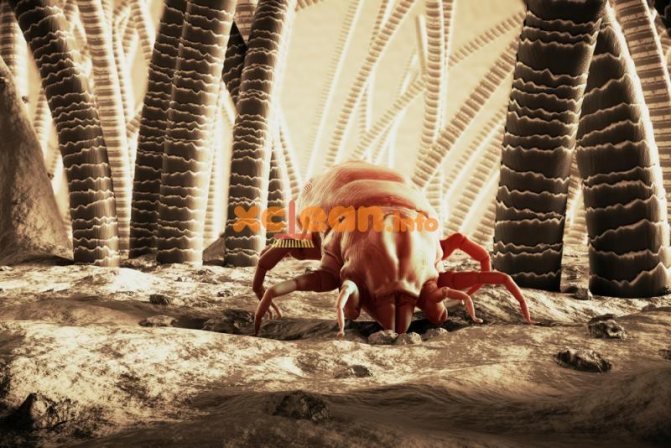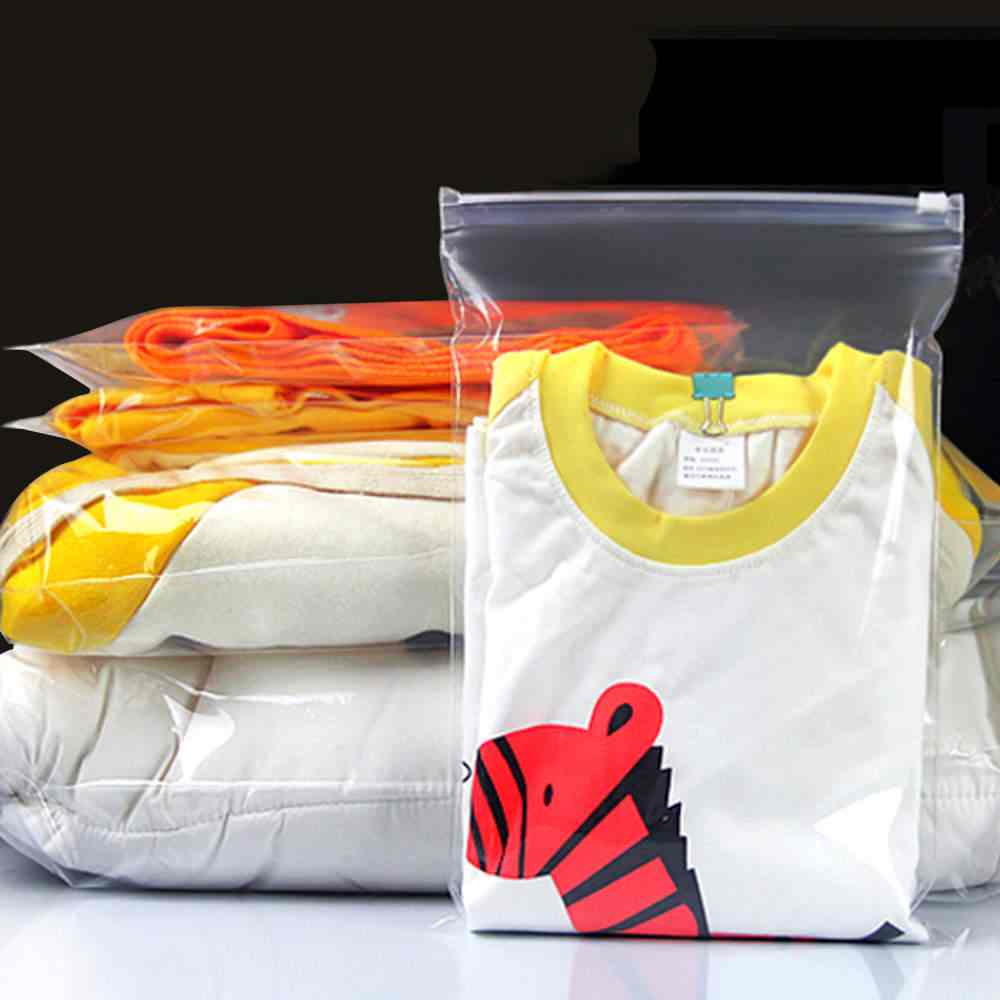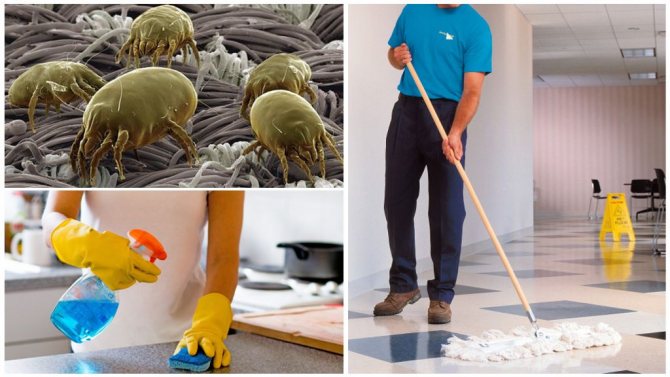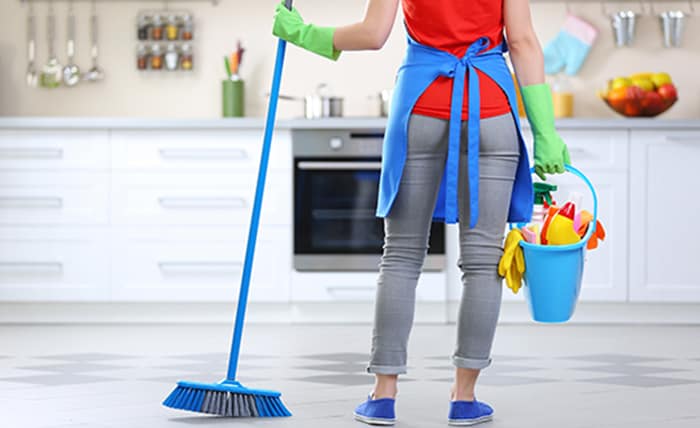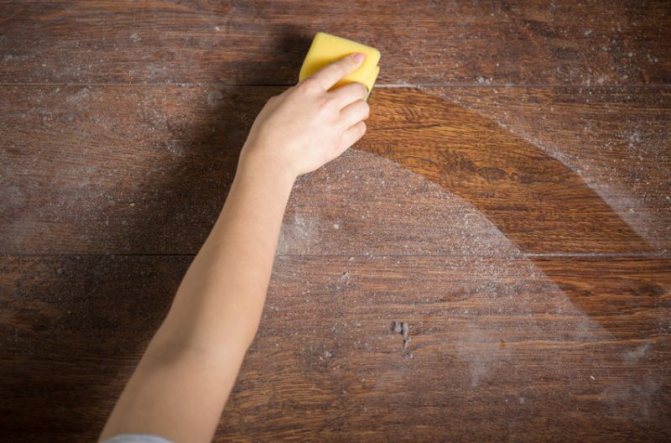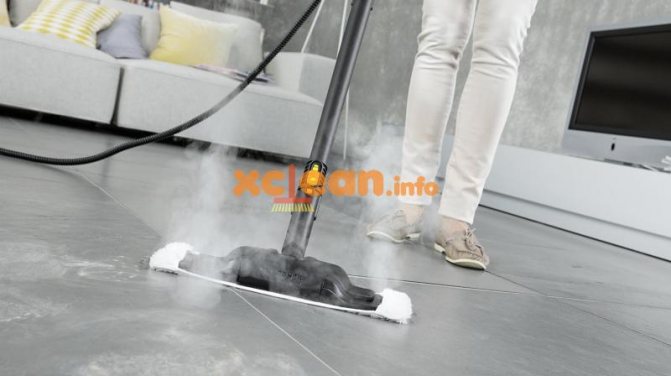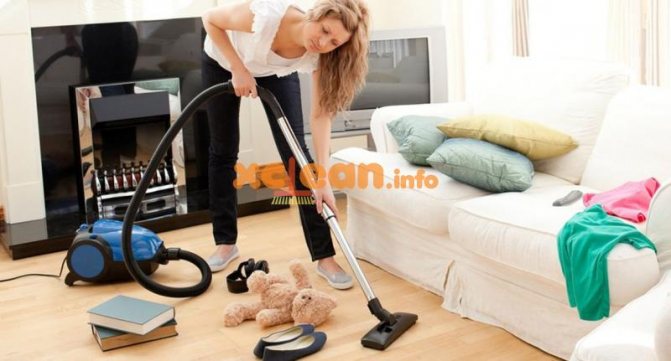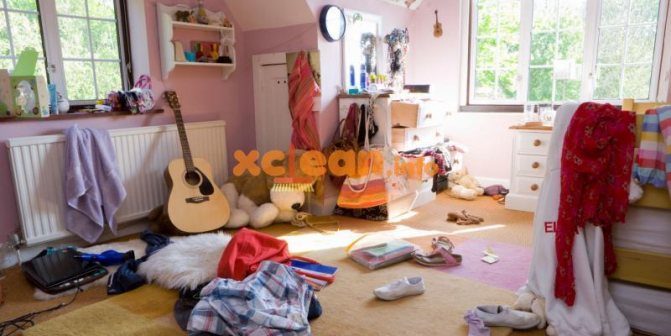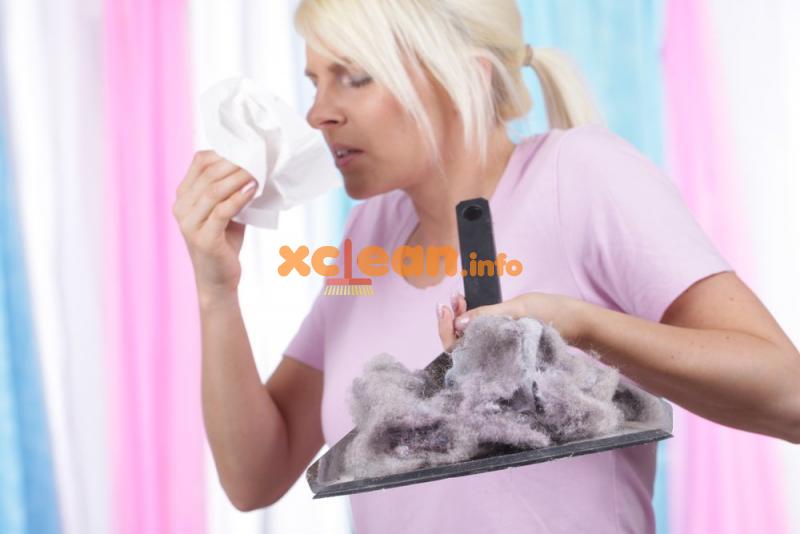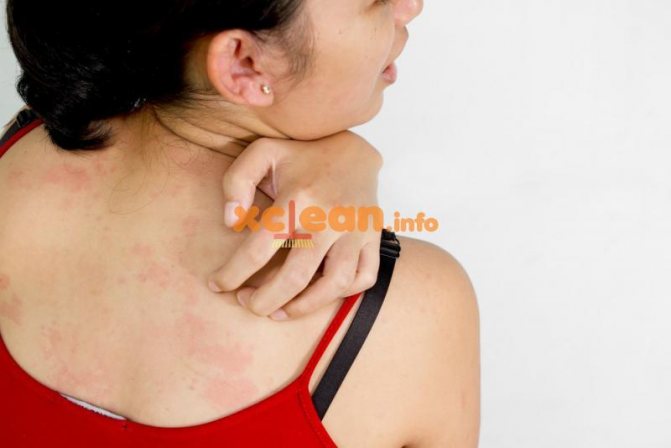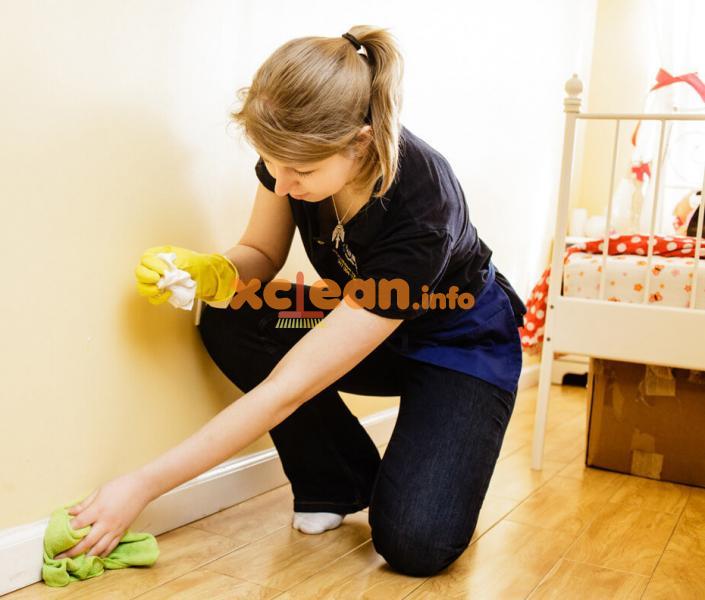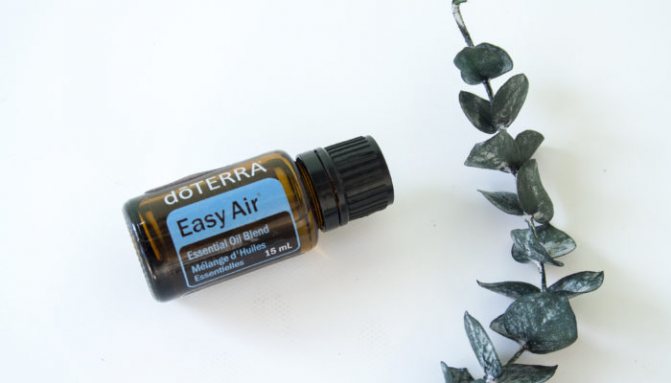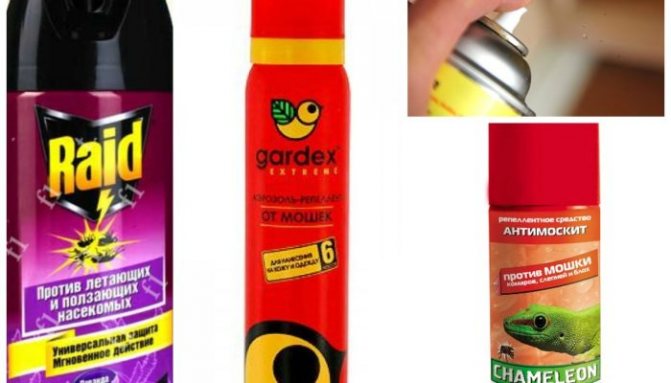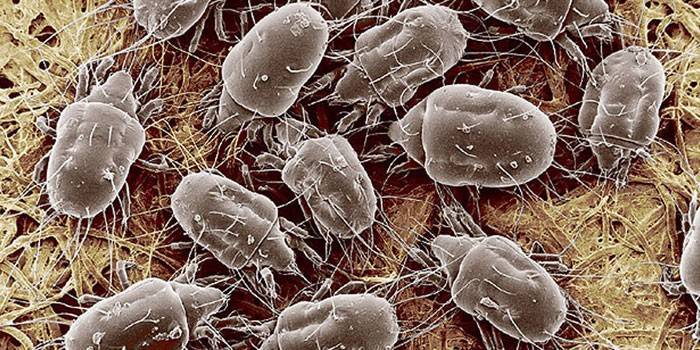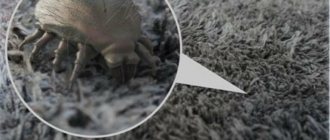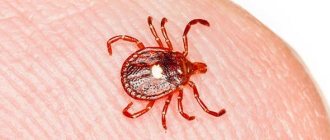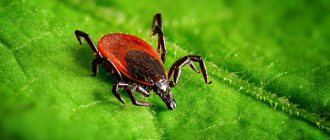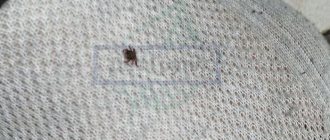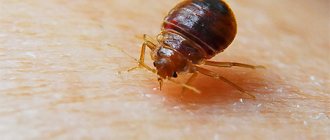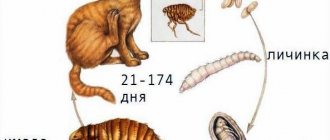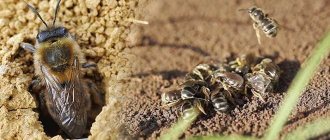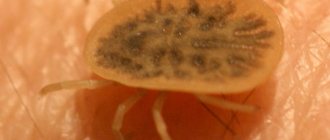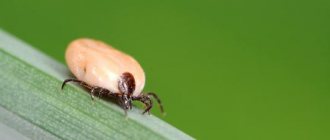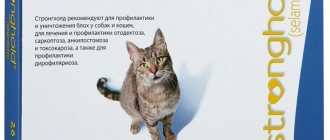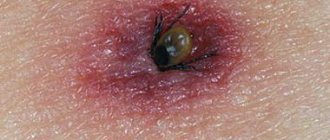Dust mites advertisements for antimicrobial agents or devices are presented as a terrifying creature that threatens absolutely everyone. In reality, the tick is dangerous only for those individuals who are prone to allergic reactions to this particular allergen. Or in the case of a significant excess of the number of mites per 1 g of dust particles. The permissible norm of these creatures in 1 gram of dust can be up to 100 pieces, but an increase in this concentration, which is sometimes caused by a favorable habitat or in the periods between August and October, can negatively affect any organism.
Dust mites or house dust mites are synanthropes that are closely associated with a person and his home. These creatures are distributed all over the world and can even be found in a perfectly clean apartment. And all because, no matter how often we do the cleaning and processing of the premises with our own hands, there will still be inaccessible places in the form of heavy furniture or built-in equipment. So it turns out that every time, devoting a lot of time to cleaning a house or apartment, we fail to achieve perfect cleanliness.
Household dust contains plenty of allergens in the form of fungal spores, mold, residues of various fibers, particles of epidermal cells of animals and humans, waste products of small insects.
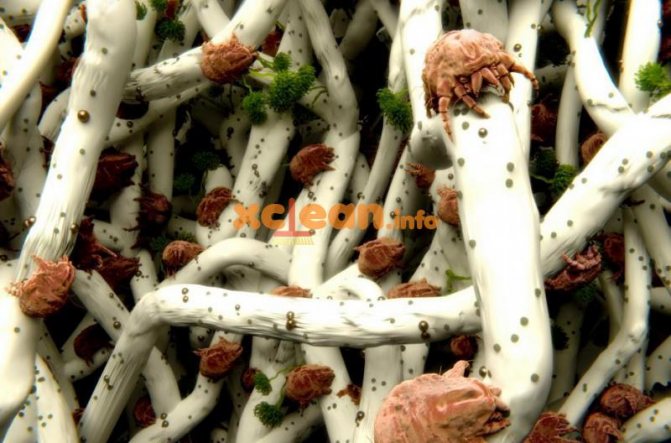
The main types of house ticks
Household ticks Is a separate biological group of parasites that live in a residential environment. They not only spoil food, clothing and furniture, but also affect human and animal health.
The following types of mites can appear and multiply in a residential environment:
- Hairy house mite... This pest lives in flour, grain, plant and animal residues, and even cheese and tobacco. Such mites actively develop at a temperature of 23-25 degrees and a relative humidity of 80-90%. They can cause dermatitis in a person;
- Scabies mite (itch)... It develops and parasitizes only on humans in high humidity and warmth. Is the causative agent of scabies;
- Rat mite... The parasite attacks mainly rats, but, in the absence of a natural host, it can attack other mammals, as well as humans. The rat mite causes a disease that is difficult to treat - rat tick-borne dermatitis. This parasite is widespread in rural areas and poses a danger to its inhabitants;
- Chicken mite... This type of parasite is widespread throughout the world. It mainly lives in nests and bird droppings, cracks in wooden surfaces. May parasitize on the surface of human skin, causing skin rashes and irritations;
- Bird tick... This tick parasitizes wild and domestic birds, that is, it lives in close proximity to humans and is capable of attacking them.
Household ticks are dangerous not only with bites, but also with the effect of their own feces on the condition of humans and pets.
Prevention of the reappearance of parasites
The most important and simple rule of dealing with dust mites is cleanliness.
- We wash floors well at least once a week.
- We vacuum 2 - 3 times a week.It is advisable to use vacuum cleaners with an Aqua filter so that parasites do not spread throughout the apartment, flying out from the back of the vacuum cleaner.
- You need to vacuum not only carpets and floor coverings, but also chairs, beds, upholstered furniture.
- Clean the closets well from old fur hats, coats, fur coats, unnecessary clothes and shoes. This is all accumulation of dust, which means a "nursery" for the dust mite. The cabinets should be spacious and clean.
- All shelves and cabinets, a computer desk, notebooks, books should be wiped with a damp, clean cloth.
- Polish lacquered furniture with polish.
- Bed linen should be changed every week by washing it in hot water.
- Store clean laundry in a dry place as humid environments tend to generate dust mites.
- Quilts, pillows made of feather and down, if you cannot throw it away, then hand it over for cleaning on time, at least 2 times a year. There the feather is washed, treated with special solutions, sewn into new pillowcases. This prevention will rid you of parasites.
- Use a dust mite repellent. These are sold to be sprayed in the room (aerosol) and to be added to the washing machine.
But the best recipe for defeating invisible tenants - dust mites - is still the regularity of cleaning your home, observing the rules of personal hygiene. It is necessary to equip your apartment so that household dust does not harm our health.
What does a dust mite look like - photo under a microscope
Dust mites invisible when viewed with the naked eye, because their length reaches only 0.5 mm. To study the details of the structure of his body is possible only with the help of a microscope.
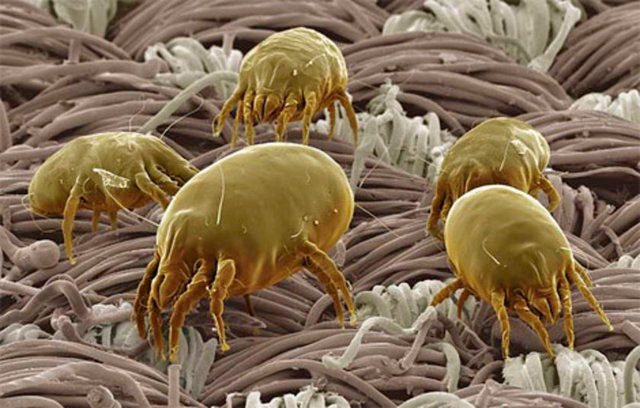

One gram of house dust can contain from hundreds to thousands of parasites. It is known that their number increases significantly from August to October, especially after the beginning of the heating season.
A tick of this species, like all arachnids, has a flattened body, consisting of separate segments connected to each other. The linen tick moves with eight legs. Each limb has suction cups, thanks to which the harmful microorganism is firmly attached to surfaces. With the help of two pairs of jaws, the parasite captures and grinds food, and also pierces the host's skin, as some mistakenly believe.
The body of dust mites is covered with a kind of water-repellent layer. If you examine the parasite with a microscope, then you can come to the conclusion that it looks like an ordinary small spider. About 150 species of mites are known to live in house dust.
Signs of presence and location of congestion
Dust mites are not visible to the naked eye. Parasites can only be viewed under a microscope with 100x magnification. However, there are several signs by which it is understood that a large number of dust mites have started up in the apartment:
- Itching, redness of the skin. When the number of parasites is large, they do not have enough food. Therefore, ticks look for it on the human body.
- Runny nose, stuffy nose.
- Lachrymation, redness of the eyes.
- Constant cough, wheezing, chest tightness.
- Rapid breathing, shortness of breath.
- Decreased appetite.
- An increase in the weight of the pillows and mattress, which indicates the accumulation of dust and, consequently, dust mites.
The unprotected body of children is most susceptible to allergic reactions. This reaction is manifested by bouts of coughing, lacrimation. The temperature does not rise
In the presence of one or more signs, attention is paid to the condition of the room: if layers of dust are visible on cabinets and cabinets, a thorough wet cleaning is carried out
Arachnids are one of the causes of asthma. If a person has an increased sensitivity to dust mite allergens, allergic rhinitis, atopic dermatitis, and conjunctivitis may develop. If you do not take action, chronic rhinitis, bronchial asthma, skin diseases, Quincke's edema develop.
Symptoms of a dust mite allergy include:
- Throat sore, tickles, causing fits of coughing.
- My nose itches and burns, I constantly want to sneeze.
- Eye irritation occurs.
- Shortness of breath and wheezing.
- The mucous membranes and skin are irritated, red spots appear on the body.
What to do if one or more of the above signs are found:
- Consult a doctor.
- If the diagnosis of dust allergy is confirmed, they do a general cleaning, clean furniture and carpets, using personal protective equipment - a gauze bandage, in order to avoid inhalation of arachnids and their feces.
- Syrups and anti-allergy tablets are taken as prescribed by a doctor: Cetrin, Suprastin, Claritin, Tavegil, Erius, Diazolin, Fexofenadine, Fenistil gel.
- Vitamin complexes are used to strengthen the immune system.
- Use means to reduce irritation of the mucous membranes and skin.
- Against nasal congestion use "Aqua-Maris", "Aqualor", "Desitin", "Losterin". The nasal passage is washed with a solution of salt dissolved in water.
Mites live in upholstered furniture, carpets, mattresses, blankets, bedding, curtains, house slippers. Ticks like feather pillows. Places of residence are any places where dust accumulates. For example, pet hair, book shelves, natural wool bedspreads and carpets.
One of the ideal habitats for dust mites is a vacuum cleaner's dust collector, which contains collected debris, pet hair, and dead epidermal cells.
If it is necessary to accurately establish the presence of mites in house dust, chemical test control systems are used. For example, Akarex, Germany. The kit includes 10 color tests, each of which includes: a chemical reagent - a 1.2 ml bag, a test strip, a dust container, a measuring spoon and a color scale for assessing the degree of dust mite infestation. Store the product in the refrigerator at a temperature of 4C.
To conduct the study, a sample of dust collected by a vacuum cleaner is placed in a liquid, stirred and briefly immersed in the test strip in the test sample. After 1 minute, a comparison is made with the reference. Determine the fact of infection and the number of dust mites: a lot or a little.
During testing, rubber gloves and a gauze bandage are used. At the end, wash your hands with soap and water.
Where do dust mites start and live?
Most often, dust mites are concentrated in the dusty environment of places that are difficult to clean, as well as in bedding. They can be found:
- In a pillow filled with natural bird feather;
- In the mattress, especially if it is old and has not been cleaned for a long time. These mattresses are said to be 10% mite;
- In a blanket stuffed with cotton wool;
- In a carpet made of natural materials, the pile of which can also be eaten by parasites;
- In bed linen;
- In furniture upholstery;
- In curtains and curtains;
- On bookshelves that are rarely dusty;
- In a bag in a vacuum cleaner;
- In soft toys made from natural materials;
- In stale old clothes;
- In woolen blankets.
According to statistics, the largest number of parasites is in the bed: up to 2 million individuals can be found here.
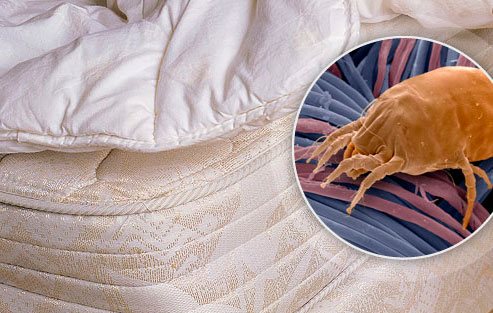

The waste products of sofa mites, which cause allergic reactions, enter the air, slowly settle on the surface and gradually accumulate. Allergens get not only on pieces of furniture and things, but also on human skin and even in the respiratory tract.
Parasite control methods
Unfortunately, it is impossible to completely eliminate the parasites. But if you make every effort, then their number can be significantly reduced. The fight against dust mites includes several stages that create conditions that are unfavorable for their living.
Destruction of "dust collectors"
Review all things carefully. Throw away old carpets, mattresses, soft toys. This also applies to old feather pillows, which were inherited from my grandmother. There is no point in cleaning products that have served for more than one year.
Estimated life of bedding:
- mattress - up to 10 years old;
- blankets - 5 years;
- pillows - 2-3 years.
After the end of their service life, even if these things are in good condition, it is better to throw them away, not to risk your health. In winter, bedding can be taken out in the cold. This will help to reduce the number of ticks by destroying their eggs.
spring-cleaning
After getting rid of old things, you can start cleaning the house. Soft toys can be dry cleaned if you feel sorry for them. Routine cleaning with a damp cloth will not be enough to get rid of pests. Although constant wet cleaning helps to reduce their population. You can add salt to the water to enhance the effect (5-10 spoons per bucket of water). You need to wipe not only the floor, but also the ceiling, walls, furniture surface. It is better to use microfiber cloths for cleaning. The structure of the fabric allows dust to collect on the napkin rather than scattering around the house.
On a note! It is recommended to ventilate the room more often, and also to reduce the humidity to 40%! At least for a month. This will create an unfavorable environment for the ticks and help reduce their numbers.
Wash
Since it is in bed that mites are most concentrated, linen should be changed regularly. Insects die at a temperature of 60 degrees. Therefore, it is necessary to wash the bed at high temperatures. You can add a few drops of eucalyptus oil to the rinse water. Its smell repels ticks.
After washing, the bed should be well dried outside, after drying, iron it with an iron. In general, it is recommended to iron all bed and clothes after washing. High temperatures can kill many parasites that are invisible to our eyes.
Chemicals
On the market, you can find products designed specifically to combat dust mites. There are also tests that determine the concentration of pests in the dust (Acarex). Treatment with surface preparations allows you to forget about ticks within 1-2 months.
How to machine wash a feather pillow correctly? Read useful information.
Funds are issued in the form:
- spray,
- powder,
- foam,
- aerosol,
- various solutions for washing.
The instructions given by the manufacturer must be strictly followed. After all, improper use of anti-tick products can cause breathing problems, asthma attacks, and skin rashes.
How do bed mites bite? Do they bite?
Many are worried about whether mattress mites bite and, accordingly, what the bite looks like. This type of parasite does not bite or spread infections. This is due to the fact that the pests are too small and cannot bite through the human skin.
The pillow mite harms in a different way, through the products of its vital activity. These include:
- Cuticle remaining after molting;
- Secrets that parasites produce;
- Feces containing proteins that cause allergic reactions.
Those who are prone to allergies should be especially careful, because the parasite causes extremely unpleasant symptoms that can develop into a serious illness. That is why, if warning signs are found, it is worth contacting an allergist or immunologist to check suspicions of a tick-borne allergy.
A rash that occurs on the skin in response to the activity of a mite is sometimes confused with bed bug bites. In fact, bed bugs, unlike ticks, leave quite specific bites: they are numerous and grouped, look like large swellings with a pronounced red compaction in the middle.
What causes ticks in bed?
Why is the bed most often attacked by dust mites? How do they get here?
The fact is that in every house, despite the diligent maintenance of cleanliness, there is a small population of these parasites. With frequent cleaning, washing and cleanliness of linen, replacing the filler in feather pillows with a more modern one, the number of mites is kept within the permissible range: they are not enough to become a source of allergies.
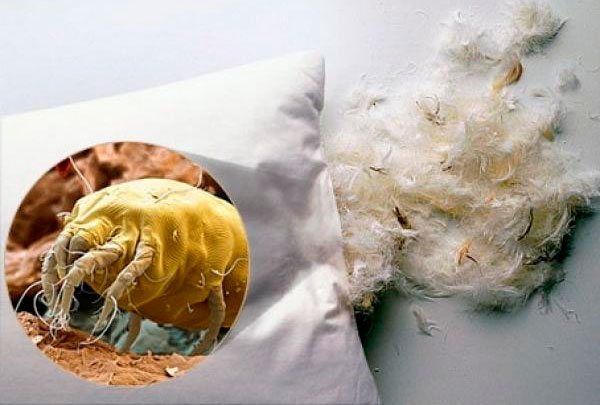

If wet cleaning of premises and bed linen is rarely performed, a large amount of keratinized skin particles accumulate in the layer of dust and on the fabric of bedding, which the clothes mites feed on. Thus, favorable conditions are created for their nutrition, development and reproduction.
You should be especially careful: bed mites are often observed in rented apartments and rooms of inexpensive hotels, in which guests often change.
Insect danger
Dust mite is considered one of the worst allergens. These parasites exist in every home. Their excrement contains enzymes that help break down dead skin particles. It is these protein substances that are potent allergens.
Parasites can provoke:
- allergic rhinitis;
- bronchial asthma;
- atopic dermatitis;
- conjunctivitis;
- acariasis;
- Quincke's edema.
All of them can be united by a common concept - sensitivity to tick-borne allergens. Before starting treatment with antihistamines, it is necessary to carry out a general cleaning in order to reduce the number of ticks as much as possible.
Means and methods of getting rid of bed mites
None of the existing methods guarantee the complete elimination of the feather mite population, but by taking the necessary measures, it is quite possible to reduce its number to a safe level. Under these conditions, you can be sure that the parasites will not cause allergies.
How to get rid of bed dust mites? There are several types of means with which you can control their vital activity.
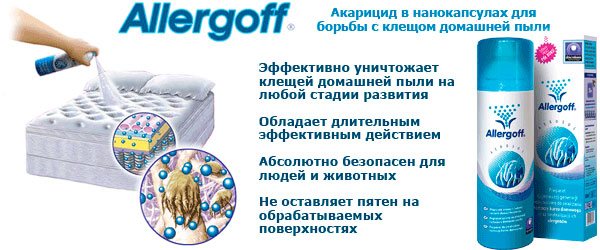

Chemicals, preparations and suspensions, the composition of which makes it possible to exterminate ticks. At the same time, they are completely safe for humans, for example:
- Spray Allergoff, which not only has a detrimental effect on pests, but also neutralizes their waste products containing allergens;
- Easy air - an organic preparation in the form of a spray. Suitable for various surfaces. Helps to eliminate allergy symptoms provoked by the activity of parasites;
- Spray can Milbiol - a remedy for bed mites, intended for the treatment of mattresses and textile surfaces. The active substances of the drug act directly on ticks, disrupting their ability to feed and stopping their development and growth;
- Dani earth - spray from a Japanese manufacturer. Suitable for cleaning upholstered furniture, toys, pillows. Has a non-sticky texture, thanks to which it dries quickly;
- Tsifox... The preparation for the treatment of premises is highly concentrated and toxic, therefore it should be used only in a diluted form and only in personal protective equipment;
- All-Rug... It is a shampoo for cleaning carpets and washing the floor, preventing the development of domestic parasites.
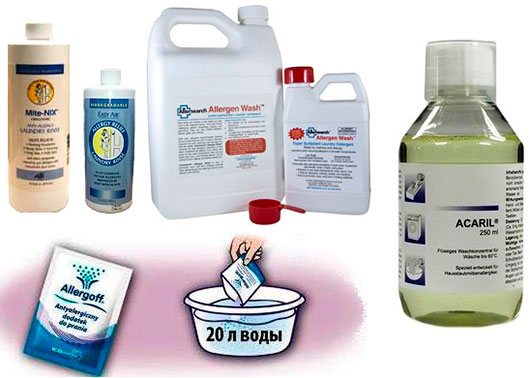

It is possible to independently prepare a product for treating places where a lot of dust and things accumulate. To do this, you need to prepare a saline solution, observing the following proportions: a liter of water per 200 g. salt. This composition will help fight household ticks.
If ticks appear in the house, then, in addition to treating the premises with chemicals, it is important to regularly ventilate and carry out wet cleaning.If there are allergy sufferers in the family, it is advisable to purchase a vacuum cleaner with an aquafilter: an ordinary vacuum cleaner not only does not neutralize allergens, but also helps to spray particles of mites and their excrement. A household steamer can destroy dust mites by exposing them to hot steam. Make it a habit to steam the mattress, blanket and pillow on both sides when changing bedding to prevent parasites. After such a procedure, the linen must be thoroughly dried.
Diagnostics
An allergic person should definitely visit an allergist if symptoms worsen at home, especially in the early morning or before bed. An allergist is a specialist who diagnoses and treats this kind of disease. Among other things, when carrying out certain diagnostic manipulations, it is possible to determine that it is the bed mites that are the cause of the corresponding condition in the patient.
The doctor will apply a variety of diagnostic tests to determine if the microscopic tick is showing symptoms. The most common type is a skin prick test. During this test, the allergist will prick the skin area with a small amount of the allergen extract.
After 15 minutes, it will be possible to see if there are any changes in the skin in the form of negative reactions at the site of a particular injection. If it shows a positive reaction to a bed mite allergen, in the causes of severe coughing, sneezing and other symptoms. There will be no more doubt. There will be severe swelling around the injection site and the area may also become red and itchy.
A blood test is sometimes used instead of a skin test
It should be noted that a blood test can only show the presence of antibodies, so the results may not be as accurate.
The best treatment option is to limit your exposure to dust mites. If that doesn't work, there are several over-the-counter or over-the-counter medications that can help relieve allergy symptoms.
However, it must be remembered that ill-considered self-medication can end in a serious condition, up to loss of consciousness, therefore, all drugs of this series are taken exclusively as prescribed by a doctor.
- Antihistamines such as Allegra and Claritin. These remedies can help reduce sneezing, runny nose, and itching.
- Nasal corticosteroids, such as Flonase or Nasonex, reduce inflammation with fewer side effects than other drugs I take by mouth.
- Decongestants such as Sudafed or Afrin reduce the swelling of the mucous membranes in the nasal passages, making breathing easier.
- Medicines that combine antihistamines and decongestants, such as Actifed or Claritin-D
Other treatments that may help include:
- Cromoline sodium.
- Leukotriene modifiers such as Singulair, Accolate, Zyflo.
- Customized immunotherapy.
Flushing your nasal passages with warm salt water on a daily basis is another effective way to remove allergens from your sinuses.
Allergic reaction to bed dust mites
Dust mites are a source of severe allergic reactions. They act on the mucous membrane of the respiratory tract and cause:
- Conjunctivitis, rhinitis, allergic dermatitis;
- Respiratory allergy;
- Rinoconjunctivitis;
- Quincke's edema;
- Bronchial asthma.
In medicine, such a reaction to household parasites is called tick-borne sensitization.
The occurrence of allergies triggered by bed mites is indicated by such signs as frequent sneezing, wheezing in the chest, suffocating cough, watery eyes, and redness of the eyes.
The disease is diagnosed through data collection, blood tests, and microbiological tests.
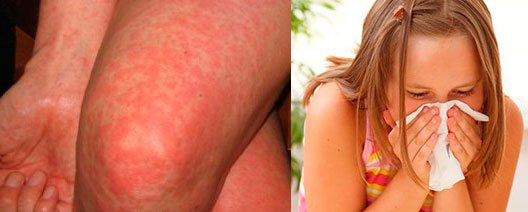

Treat dust mite allergies by limiting patient exposure to allergens, medication, and desensitization. These are measures aimed at reducing the body's perception of allergens. For these purposes, an allergen extract is administered to a person, gradually increasing the dosage and concentration. With the help of desensitization, the allergy sufferer's body does not react so strongly to the source of irritation.
Allergens
In addition to the main culprit of house dust allergy - waste products of the Demodex mite, this disease can be caused by other allergens contained in dust particles:
- hairs of pets, including cats and dogs, hamsters and guinea pigs, and so on;
- the remains of cockroaches and other beetle insects that are found in the house;
- bird down, from which pillows, blankets, feather beds are made;
- book dust - waste products of paper microorganisms;
- mold and other fungal formations that appear in damp rooms.
Symptoms
Different types of allergies have similar symptoms, so the diagnosis is complicated and requires special research.
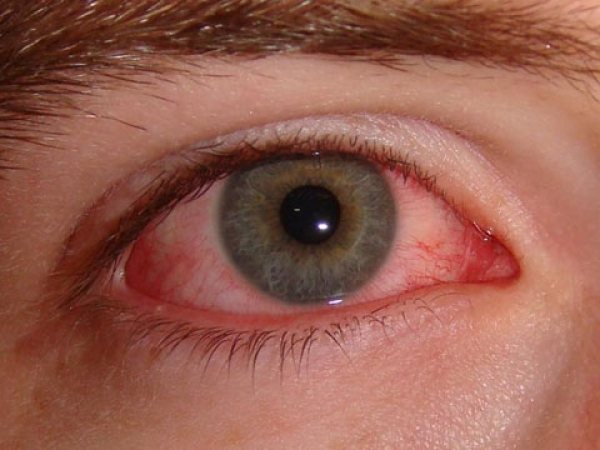

Photo: Redness of the clases
Signs of dust allergy include:
- runny nose, while the phenomena of rhinitis are prolonged, accompanied by sneezing, accumulation of mucus in the nose;
- redness of the eyes, accompanied by lacrimation, and turning into conjunctivitis;
- inflammation of the mucous membrane of the respiratory tract, provoking a cough;
- edema of the mucous membranes of the larynx, bronchi, leading to shortness of breath and suffocation.

